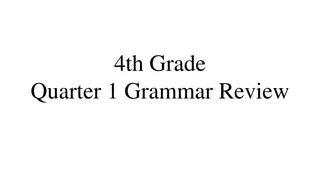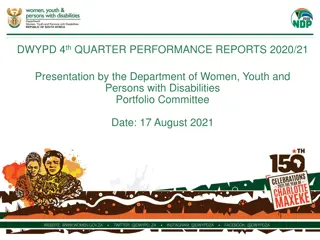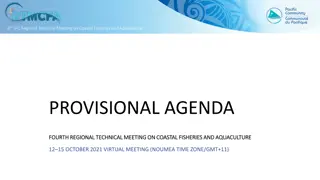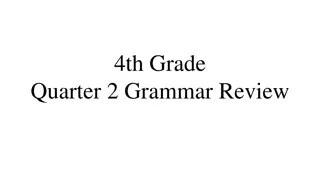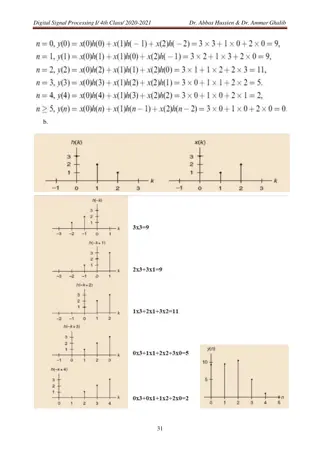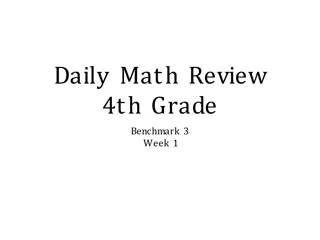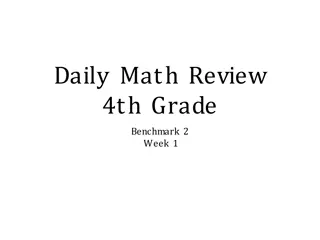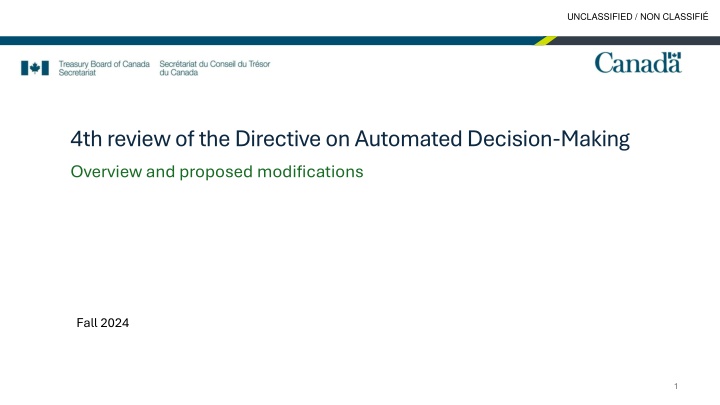
Review of Automated Decision-Making Directive
The article presents an overview of the 4th review of the Directive on Automated Decision-Making, discussing proposed modifications and seeking feedback on policy recommendations. It highlights the importance of AI governance in government decisions, emphasizing transparency, accountability, and procedural fairness. The Directive outlines requirements such as Algorithmic Impact Assessment, Quality Assurance, Transparency, Recourse, and more to ensure responsible use of automated systems.
Download Presentation

Please find below an Image/Link to download the presentation.
The content on the website is provided AS IS for your information and personal use only. It may not be sold, licensed, or shared on other websites without obtaining consent from the author. If you encounter any issues during the download, it is possible that the publisher has removed the file from their server.
You are allowed to download the files provided on this website for personal or commercial use, subject to the condition that they are used lawfully. All files are the property of their respective owners.
The content on the website is provided AS IS for your information and personal use only. It may not be sold, licensed, or shared on other websites without obtaining consent from the author.
E N D
Presentation Transcript
UNCLASSIFIED / NON CLASSIFI 4th review of the Directive on Automated Decision-Making Overview and proposed modifications Fall 2024 1
UNCLASSIFIED / NON CLASSIFI Purpose Provide an overview of the 4th review of the Directive on Automated Decision- Making Seek feedback on policy recommendations and proposed modifications Discuss proposed updates 2
UNCLASSIFIED / NON CLASSIFI Background Providing better programs and services for Canadians sometimes involves the use of artificial intelligence (AI) to support sound decision making The Government of Canada (GC) is committed to ensuring that the government's use of AI is governed with clear values, ethics and laws, and in accordance with human rights Treasury Board of Canada Secretariat (TBS) is responsible for providing government- wide direction on information and data governance, information technology, security, privacy and access to information. The Directive on Automated Decision-Making (directive) sets rules for how federal departments can use automated systems (including AI) to make or support decisions that impact the legal rights, privileges or interests of clients. For example: o determining eligibility for permits and benefits o assessing eligibility for entry to Canada o deciding to hire an individual to work in the public service o granting market authorization for a pharmaceutical product o launching an investigation into an individual s conduct 3
UNCLASSIFIED / NON CLASSIFI Directive on Automated Decision-Making The directive seeks to ensure transparency, accountability and procedural fairness in the use of automated decision systems in the federal government. It requires departments to: assess the impacts of automated decision systems be transparent ensure quality provide recourse on decisions report publicly on system effectiveness and efficiency The directive came into effect in April 2019 and applies to systems developed or procured after April 2020. 4
UNCLASSIFIED / NON CLASSIFI Overview of the Directive on Automated Decision-Making Directive on Automated Decision-Making Requirements Algorithmic Impact Assessment Quality assurance Transparency Recourse Understand Communicate Prevent Correct AIA before production AIA when scope or functionality changes Publication of AIA results Notice before decisions Explanation after decisions Access to components Release of source code Documentation of decisions Publication of results in meeting program objectives Testing and monitoring of outcomes Data quality Data governance Peer review GBA Plus Employee training Continuity management Security Consultation with legal services Human intervention Recourse options to challenge decisions
UNCLASSIFIED / NON CLASSIFI Algorithmic impact assessment (AIA) Mandatory risk assessment tool Determines the impact level of an automated decision-system 51 risk and 34 mitigation questions Scores based on many factors including systems design, algorithm, decision type, impact and data Developed based on best practices in consultation with both internal and external stakeholders Developed in the open, and available to the public for sharing and re-use under an open license https://www.canada.ca/en/government/system/digital-government/digital-government-innovations/responsible-use-ai/algorithmic-impact- assessment.html 6
UNCLASSIFIED / NON CLASSIFI Reviewing the Directive The directive must be reviewed every 2 years to keep the instrument relevant and reflect the evolving technology and regulatory landscape. 1st review (2020-21) 2nd review (2021-22) 4th review (2024-25) 3rd review (2022-23) Strengthen transparency and quality assurance Update references to policy instruments Clarify requirements Author guidelines supporting interpretation of requirements Expand scope Strengthen transparency and quality assurance Enable inclusive approaches Improve coherence with other policies Assess reasons for automation Assess impacts on persons with disabilities Clarify requirements Underway summer 2024 to 2025 Support effective implementation Strengthen client protections Enhance assessment of impacts 7
UNCLASSIFIED / NON CLASSIFI 4th review intended outcomes Implementing the proposed updates would: Improve protections to clients and federal institutions Strengthen compliance with the directive Reinforce commitments to transparency and accountability Clarify and improve understanding of requirements and AIA questions to align with intent and interpretation in practice Reduce redundancies and misalignment across the TBS policy suite 8
UNCLASSIFIED / NON CLASSIFI Overview of key themes and issues Three themes with 7 topics have been identified to address in the 4th review. Each theme has a goal and recommendations to achieve it. Support effective implementation Strengthen client protections Enhance assessment of impacts Monitor policy implementation Reduce the number of organizations excluded from directive Adopt internationally recognized definition of AI Clarify obligations and enhance impact assessment of human rights Strengthen protections and assessment of impacts forpersons with disabilities Identify banned uses Clarify and enhance the AIA In addition to the changes across 3 themes, additional changes are proposed to improve clarity, reduce redundancies and align with other policy instruments. All proposed changes to the Directive and AIA are available on our GCwiki page 9
UNCLASSIFIED / NON CLASSIFI Support effective implementation Monitoring policy implementation Excluded organizations Definition of AI Increase and verify departmental compliance with the directive to support improved outcomes for clients, federal institutions and Canadian society. Increase the number of organizations that are subject to the directive to expand protections and reduce risks to clients, federal institutions, and Canadian society. Remove the Excluded organizations subsection 9.1.1, such that the directive would apply to Agents of Parliament Align the GC definition of AI with a more recent and internationally-recognized definition, increasing compatibility and facilitating understanding. Remove the definition of AI from Appendix A of the directive Modify the definition of AI in Appendix A of the Policy on Service and Digital to align with the OECD definition Goal Add a new reporting requirement for departments to submit a report signed by the responsible assistant deputy minister (ADM) to TBS confirming compliance with the Directive. Add clarity to the role of the CIO of Canada related to compliance monitoring. Add a responsibility for TBS to publish an annual summary of the compliance reports on the Open Government Portal. Add a requirement for the responsible ADMto approve the completed AIA prior to its publication. Recommendations 10
UNCLASSIFIED / NON CLASSIFI Strengthen client protections Human rights Persons with disabilities Bans Goal Clarify obligations and enhance impact assessmentof human rights Strengthen protections and assessment of impacts for persons with disabilities, raising awareness of the impacts of automated decision systems Add a requirement to document system failures and take corrective actions Add new AIA questions to capture compliance with existing accessibility standards and broaden the consideration of impacts Identify explicit limits or define circumstances in which automated systems pose an unacceptable risk Recommendations Modify the testing and monitoring requirements in the directive to more clearly reference human rights Add targeted questions to the AIA to strengthen the consideration of impacts to a broader range of people Add a requirement in the Policy on Service and Digital to provide parameters for use Add a requirement and an appendix to the Directive on Service and Digital and prepare supporting guidance to state uses of AI considered unacceptable by the GC 11
UNCLASSIFIED / NON CLASSIFI 6. Examples of unacceptable AI uses Unacceptable use Example of unacceptable use case To manipulate or deceive in a way that alters behaviour resulting in harm or impacts to individual autonomy and fundamental freedoms Using deepfake technology that can spread misinformation, manipulate public opinion, and lead to increased polarization. To score or classify people in a way that leads to unjustified censorship or surveillance or that impacts freedom of expression, privacy, and autonomy Biometric categorization to infer personal information about individuals such as their race, political affiliation, religion, sexual orientation, gender identify and expression, and disability status Collectingsocial behaviour and inferred, predicted or observed personal characteristics over time to create a score that impacts individuals and groups ability to function in society. Usingphysical characteristics such as hair and eye colour to infer a person s ethnicity. Untargeted facial recognition scraping with the intent to create or expand databases Taking publicly available images from the internet for identity verification Real-time and remote biometric identification systems used in public spaces, with limited exceptions when the risk of harm is outweighed by the benefit Using real-time facial recognition to identify individuals that are subject to a regulatory fine. Relying on AI to infer emotions with the goal of determining risk, capabilities or skills or to make a decision without human oversight. Emotion recognition Determining the risk of a person or group committing an offence based solely on AI profiling or AI assessment of personality traits Relying on the use of predictive policing techniques to forecast criminal activity. 12
UNCLASSIFIED / NON CLASSIFI Enhance assessment of impacts AIA modifications Goal Increase clarity and thoroughness of the AIA tool Recommendations Add questions in AIA sections where gaps exist or that support other areas of the 4th review Modify and add questions to respond to feedback and clarify intent Editorial changes All changes to the AIA can be found here 13
UNCLASSIFIED / NON CLASSIFI Tell us what you think We are seeking your input on the recommendations and directive edits as part of the 4th review of the directive. Please respond to the survey where you will be asked to: o confirm if the recommendations help to achieve the topic goals o share specific edits to the updated text of the directive and AIA o identify any concerns or gaps o provide input on the approach to the "bans" topic We recommend that you refer to the following documents as you complete the survey: o Overview of the 4th review of the Directive on Automated Decision-Making o Text changes to the Directive o Text changes to the AIA tool The survey will be open from November 19, 2024 to January 8, 2025 14
UNCLASSIFIED / NON CLASSIFI Next steps Review the 4th review materials and respond to the survey by January 8 Timeline 15
UNCLASSIFIED / NON CLASSIFI Questions for discussion Do the proposed updates appropriately address the goals for the 7 identified topics? Why or why not? Are there any proposed changes to the Directive or AIA that are concerning? Is there a theme or topic that is missing? 16
UNCLASSIFIED / NON CLASSIFI Questions? Please reach out to the TBS Responsible Data and AI team (ai-ia@tbs-sct.gc.ca) 17



